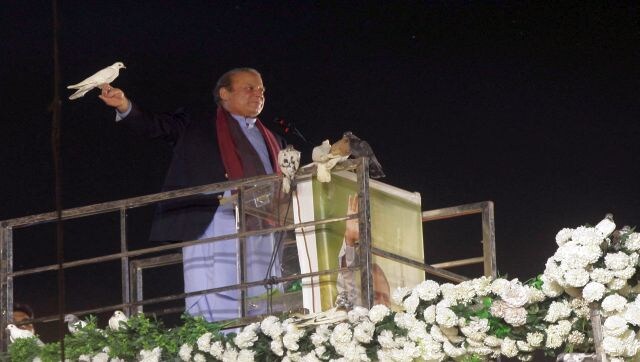Former Pakistan prime minister Imran Khan’s woes continue. On Monday (23 October), the Pakistan Tehreek-e-Insaf (PTI) chief was indicted with leaking classified documents in the cipher case and faces a possible 14-year prison term. The vice-chairman of Khan’s PTI party, Shah Mahmood Qureshi, a former foreign minister, has also been indicted over the case. The judge in the matter has issued notices to the witnesses to appear on 27 October and adjourned the hearing till then. A PTI spokesman was quoted as telling AFP that both men were charged under the colonial-era Official Secrets Act in a trial “conducted within the court premises with no access to public or media”. “We are going to challenge it,” Khan’s lawyer Umar Khan Niazi told reporters, adding that both the leaders had pleaded not guilty in the matter. What is the cipher case? The case facing
Imran Khan
pertains to him making public a confidential diplomatic cable and keeping it in his possession. It all began in March 2022 when Khan brandished the letter, which he claimed contained details of a threat made by the United States against his government, at a public gathering in Islamabad. He claimed that it was evidence of an “international conspiracy” backed by the US to topple his government. At the time he didn’t reveal the contents of the letter nor mentioned the name of the nation that had sent it. However, a few days later, Khan said that the letter was about former Pakistan ambassador to the US Asad Majeed’s meeting with Assistant Secretary of State for South and Central Asia Affairs Donald Lu. The former prime minister, claiming that he was reading contents from the cipher, said that “all will be forgiven for Pakistan if Imran Khan is removed from power”. It’s important to note here that since his ouster from power, Khan and his party have maintained that the US has conspired to remove him from his position, a claim that both Washington and even Pakistan’s National Security Council has refuted. Months later, two audio leaks brought the matter back into the spotlight when it was revealed that Imran Khan, then federal minister Asad Umar and Khan’s then-principal secretary Azam Khan were discussing how the cipher could be used in their interest. Following the audio leak, in October last year, the Shehbaz Sharif government then gave the green signal to initiate action against the former prime minister and handed over the case to the Federal Investigation Agency (FIA). Last month, the case took a turn when Azam Khan, according to a report by GeoTV, “recorded” a statement, terming the US cipher a “conspiracy” used by the ex-PM to “manipulate for creating a narrative against establishment and opposition”. Following this, Pakistan’s then Interior Minister Rana Sanaullah said that Imran Khan had committed a crime for which he should be “punished at all costs”. “Making a classified document or a (piece of) information public and then taking it into one’s possession – no person is legally eligible to have it (cipher) in their custody,” he said. The US website, The Intercept, had reported that in the missing cipher, Lu raised the issue of the no-confidence vote against Imran Khan: “I think if the no-confidence vote against the prime minister succeeds, all will be forgiven in Washington because the Russia visit is being looked at as a decision by the prime minister,” Lu said, according to the document. “Otherwise,” he continued, “I think it will be tough going ahead.” When asked about these remarks, the US State Department spokesperson Matthew Miller had said: “Nothing in these purported comments shows the United States taking a position on who the leader of Pakistan should be.” [caption id=“attachment_13285772” align=“alignnone” width=“640”] Pakistan Tehreek-e-Insaf (PTI) party activists and supporters protest against the arrest of Pakistan’s former Prime Minister Imran Khan. Many of his supporters believe that the cases against him are a way to block him from contesting polls next year. File image/AFP[/caption] What the indictment means for Imran Khan? The indictment in the cipher case is a big blow to Imran Khan, who’s all tangled up in legal cases since his ouster from power last April. According to lawyers, the charges he faces in the cipher case carry a possible 14-year prison term, and in extreme cases, could amount to the death penalty. The former PM, who enjoys mass support in the country, was earlier sentenced to three years in prison in the
Toshakhana case
and was moved to the Adiala jail. However, in August, the Islamabad High Court suspended the Pakistani leader’s conviction. Apart from this, the PTI chief also faces a slew of other cases – almost
121
– including committing treason and blasphemy and inciting violence and terrorism. Political analyst Rasul Bakhsh Rais told AFP, “He is facing legal matters but the intent of the regime is quite clear – that they don’t want to leave any corner for his escape, regardless of whether the charges are real or fabricated.” [caption id=“attachment_13285792” align=“alignnone” width=“640”]
Pakistan Tehreek-e-Insaf (PTI) party activists and supporters protest against the arrest of Pakistan’s former Prime Minister Imran Khan. Many of his supporters believe that the cases against him are a way to block him from contesting polls next year. File image/AFP[/caption] What the indictment means for Imran Khan? The indictment in the cipher case is a big blow to Imran Khan, who’s all tangled up in legal cases since his ouster from power last April. According to lawyers, the charges he faces in the cipher case carry a possible 14-year prison term, and in extreme cases, could amount to the death penalty. The former PM, who enjoys mass support in the country, was earlier sentenced to three years in prison in the
Toshakhana case
and was moved to the Adiala jail. However, in August, the Islamabad High Court suspended the Pakistani leader’s conviction. Apart from this, the PTI chief also faces a slew of other cases – almost
121
– including committing treason and blasphemy and inciting violence and terrorism. Political analyst Rasul Bakhsh Rais told AFP, “He is facing legal matters but the intent of the regime is quite clear – that they don’t want to leave any corner for his escape, regardless of whether the charges are real or fabricated.” [caption id=“attachment_13285792” align=“alignnone” width=“640”] Nawaz Sharif prepares to release a pigeon in front of supporters, following his arrival from a self-imposed exile in London, ahead of the 2024 Pakistani general election, in Lahore, Pakistan. Reuters[/caption] What about the Nawaz Sharif factor? Notably, the indictment comes at a time when Khan’s primary opponent and three-prime minister
Nawaz Sharif
returned to the country, ending his four-year self-exile. On his return on Saturday, the chief of the Pakistan Muslim League-Nawaz (PML-N) party in a rally in Lahore at Minar-i-Pakistan said that he had “no wish for revenge” and stressed on beginning a “new journey” towards growth. The PML-N supremo lamented how the country was in a dire state today but at the same time vowed to redirect Pakistan to the path of growth. Many believe that Sharif’s speech will also set the tone for what will probably be the PML-N’s narrative going forward into the elections. It’s a crucial time for Pakistan. The country is facing overlapping security, economic and political crises ahead of polls in January 2024. With inputs from agencies
Nawaz Sharif prepares to release a pigeon in front of supporters, following his arrival from a self-imposed exile in London, ahead of the 2024 Pakistani general election, in Lahore, Pakistan. Reuters[/caption] What about the Nawaz Sharif factor? Notably, the indictment comes at a time when Khan’s primary opponent and three-prime minister
Nawaz Sharif
returned to the country, ending his four-year self-exile. On his return on Saturday, the chief of the Pakistan Muslim League-Nawaz (PML-N) party in a rally in Lahore at Minar-i-Pakistan said that he had “no wish for revenge” and stressed on beginning a “new journey” towards growth. The PML-N supremo lamented how the country was in a dire state today but at the same time vowed to redirect Pakistan to the path of growth. Many believe that Sharif’s speech will also set the tone for what will probably be the PML-N’s narrative going forward into the elections. It’s a crucial time for Pakistan. The country is facing overlapping security, economic and political crises ahead of polls in January 2024. With inputs from agencies
Imran Khan indicted in cipher case: What this means for former Pakistan prime minister
FP Explainers
• October 23, 2023, 14:58:21 IST
Former Pakistan PM Imran Khan’s legal woes continue to haunt him. The popular leader has been indicted by a special court under the Official Secrets Act in the missing cipher case. If proven guilty, the maximum punishment carries a 14-year prison term, and in very extreme cases, the death penalty
Advertisement
)
End of Article